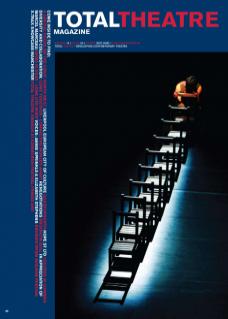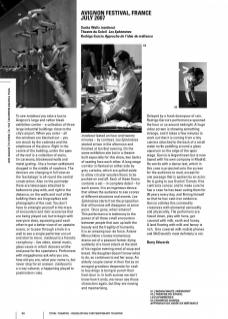To see insideout you take a bus to Avignon’s large and rather bleak exhibition centre – a collection of three large industrial buildings close to the city’s airport. When you enter – all the windows are blacked out – you are struck by the vastness and the emptiness of the place. Right in the centre of the building, under the apex of the roof is a collection of stairs, tin caravans, blockwood walls and metal grating– like a human settlement dropped in the middle of nowhere. The dancers are changing in full view as the ‘backstage’ is all round the central construction. Also on the perimeter there are telescopes attached to balloons to play with, and right in the distance, on the walls and roof of the building there are biographies and photographs of the cast. You don’t have to entangle yourself in the maze of encounters and mini-scenarios that are being played out, but to begin with everyone does, squeezing past each other to get a better view of an upstairs scene, or to peer through a hole in a wall to see a single performer uncurl and start to move. insideout is a frenetic cacophony – live video, atonal music, glass cases in which dancers writhe and pose for the spectators. Performers with megaphones ask who you are, how old you are, what your name is, but never stop for an answer. insideout is a crazy cabaret, a happening played to postmodern rules.
insideout lasted an hour and twenty minutes – by contrast, Les Ephémères started at two in the afternoon and finished at ten that evening. On the same exhibition site but in a theatre built especially for this show, two banks of seating face each other. A long stage corridor is flanked on either side by grey curtains, which are pulled aside to allow circular wooden floors to be pushed on and off. Each of these floors contains a set – in complete detail – for each scene. It is an ingenious device that allows the audience to see scores of different situations and events. Les Ephémères starts from the proposition that all humans will disappear at some point. Once gone, what remains? This performance is testimony to the power of all those small encounters between people that sum up both the beauty and the fragility of humanity. It is an amazing tour de force. Ariane Mnouchkine creates momentous drama out of a peasant farmer dying suddenly of a heart attack at the start of his regular evening meal of soup and bread. His daughter doesn’t know what to do, so continues to eat her soup. An elderly couple cower in their flat as an enraged grandson desperate for cash to buy drugs is trying to punch their front door in. In both scenes we don’t know how it ends, we never see those characters again, but they are moving and mesmerising.
Delayed by a freak downpour of rain, Rodrigo Garcia’s performance spanned the hour or so around midnight. A huge video screen is showing something strange, and it takes a few minutes to work out that it is coming from a tiny camera attached to the back of a small water turtle paddling around a glass aquarium on the edge of the open stage. Garcia is Argentinean but is now based with his own company in Madrid. He works with a dense text, which in this case is projected onto the screen for the audience to read, except for one passage that is spoken by an actor. He is going to sue Dunkin’ Donuts if he contracts cancer, and to make sure he has a case he has been eating them for 26 years every day, and filming himself so that he has cast-iron evidence. Garcia collides this commodity crassness with elemental sensuality and physicality. The performers are hosed down, play with hens, get covered with milk, earth and honey. A land flowing with milk and honey is rich. One covered with mobile phones and McDonald’s most definitely is not.

